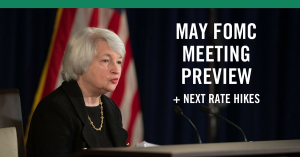Fight information overload! Help your clients outperform markets with The Sevens Report—start your free trial today.
FOMC Decision: The Fed increased the Fed Funds rate 25 basis points, as expected.
Wednesday’s Fed decision was not the dovish hike the market was expecting, although it wasn’t exactly a hawkish decision, either (even considering Yellen’s balance sheet surprise). Looking at the statement, the Fed wasn’t as dovish in its language as the consensus expected. The economic growth language remained good, and actually improved a bit from the May statement.
The inflation language, as expected, was downgraded, but the Fed refrained from changing the characterization of risks, and left them “roughly balanced.” That’s Fed speak for “any meeting is live for a rate hike.”
However, the Fed did note the undershooting of inflation recently, and explicitly said they are monitoring inflation, meaning if it continues to underperform they will react with easier policy. For now, the best way to characterize the statement is “steady as she goes,” with regard to the Fed’s current outlook.
Wildcard to Watch: Balance Sheet Reduction
We were right to make this our wildcard to watch, as the topic of the balance sheet provided the only real surprise in yesterday’s Fed meeting.
Importantly, the Fed gave guidance on all three major balance sheet related questions: When will it reduce the balance sheet? How will it reduce the balance sheet? What holdings will it reduce?
What will it reduce: The Fed revealed that it will simultaneously reduce holdings of both Treasuries and Mortgage Backed Securities, which was generally expected.
How will it reduce its balance sheet: The Fed will implement a rising monthly “cap” on principal reinvestments. What that means, practically, is the Fed will not reinvest the first $6 billion of Treasury principal and the first $4 billion of MBS principal, making it a total of $10 billion that it won’t reinvest each month, at least initially. That cap will rise by $10B every three months, so one year from the start date (which will likely be September), the Fed will no longer be reinvesting $50B worth of bond principal payments per month. That number and this escalation is not surprising, and was close to in line with most forecasts (i.e. this wasn’t “hawkish.”)
When will the Fed start Reducing the balance sheet: This was the surprise, as Fed Chair Yellen said balance sheet reduction could start “relatively soon.” That is sooner than expected, as the consensus was the Fed would hike rates again in September, and start to reduce the balance sheet in December. Now, that may be flipped.
Since reduction of the balance sheet is like the Fed hiking rates, this was taken as mildly hawkish, and the dollar bounced along with bond yields. However, this surprise is not a hawkish gamechanger, and won’t alter anyone’s outlook on Fed policy going forward.
Bottom line, for all the noise and production yesterday, the Fed outlook remains broadly the same: One more rate hike and balance sheet reduction in 2017, unless inflation metrics get much worse.
For a monthly cost of less than one client lunch, we firmly believe we offer the best value in the independent research space. Start your free trial of The Sevens Report today.

